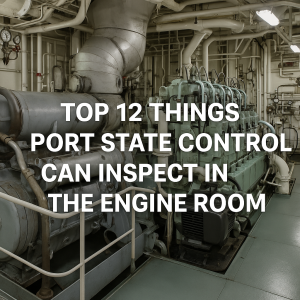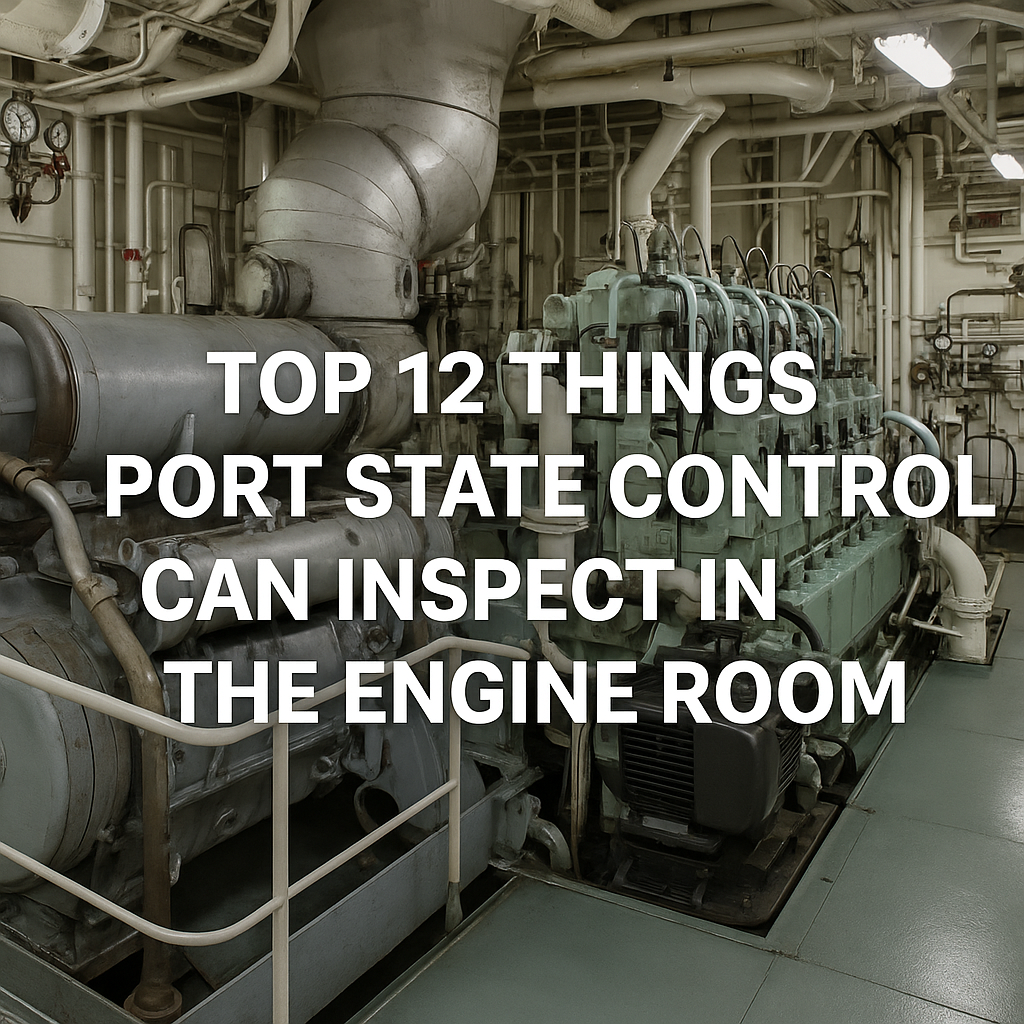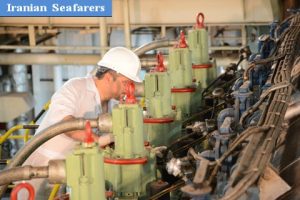Discover the 12 key items Port State Control can inspect in a ship’s engine room. Understand critical safety, pollution prevention, and compliance checks through this detailed, globally-focused maritime guide.
Imagine this: your ship has arrived at a busy port, and the Port State Control (PSC) officer steps on board. You know the drill — certificates, logbooks, drills — but once they step into the engine room, the pressure truly begins. For many engineers, this is the most challenging part of any PSC inspection. It is not just about ticking boxes, but about showing competence, safe practices, and readiness to protect life, the environment, and the ship itself.
Port State Control inspections are mandated under international conventions such as SOLAS, MARPOL, and the STCW Code. Their purpose is simple yet vital: keep substandard ships out of the world’s harbours. Because the engine room is the beating heart of a ship, its safety, maintenance, and environmental controls are high-priority inspection points.

In this detailed article, we will guide you through the 12 most common things that Port State Control officers look for in the engine room, supported by real-world stories, regulations, and global maritime best practices.
Why Engine Room Inspections Matter in Modern Maritime Operations
The statistics are sobering. According to the Paris MoU Annual Report 2023, engine-room-related deficiencies are among the top five causes of ship detentions in Europe. Failures in oil filtering equipment, emergency generators, and fire safety systems can create catastrophic accidents.
In the words of the IMO: “The engine room is a high-risk environment requiring consistent, verifiable standards.” A PSC officer does not look for perfection but for compliance — ensuring that the ship’s systems function properly, crew know how to use them, and pollution is controlled.
In an era where the public and regulators are increasingly demanding environmentally responsible shipping, the stakes have never been higher. Engine-room inspections are a frontline measure protecting our oceans, our atmosphere, and the people who work at sea.
Key Technologies and Developments Shaping Engine Room Compliance
Modern ships are evolving fast. Just ten years ago, PSC officers rarely checked a ship’s data logging of engine emissions. Today, with IMO MARPOL Annex VI fully in force, they absolutely do.
Some other changes in the last 5 years include:
-
Ballast Water Treatment Systems (BWTS): as required by the BWM Convention
-
Advanced oily water separators with 15 ppm monitors
-
NOx and SOx emissions monitoring under MARPOL
-
Automatic engine alarm monitoring systems (with data backups)
-
Urea-based SCR systems on dual-fuel engines
PSC officers now expect these technologies to be operational, correctly maintained, and properly documented. Any slip — even a broken sensor — could trigger a deficiency or even a detention.
–
The Top 12 Engine Room Items Port State Control Can Inspect
Let’s break these down with practical insights, so maritime professionals, cadets, and enthusiasts truly understand what to expect.
Emergency Generator
The emergency generator is a PSC priority. It must start immediately and automatically provide power to essential systems in case of a blackout. SOLAS Chapter II-1 Regulation 43 is crystal clear: this generator cannot fail. PSC officers will usually ask for a demonstration, observing starting time, load transfer, and alarm systems.
Oily Water Separator
MARPOL Annex I requires strict pollution controls, and PSC officers often check the oily water separator’s working order, including alarms and automatic stopping functions at 15 ppm. Crew must demonstrate knowledge of operating procedures and show the oil record book entries.
Fire Main System
In the engine room, the fire main must deliver water instantly if a fire breaks out. PSC checks the isolation valves, pumps, pressure levels, and hoses for leaks, corrosion, or faulty couplings.
Fixed Fire-Fighting Systems
CO2 systems, foam systems, or dry powder — these must be fully charged and ready. PSC inspectors may ask you to trace the lines, explain the release sequence, and verify that no unauthorized modifications have been made.
Emergency Fire Pump
SOLAS expects the emergency fire pump to operate even if the engine room is flooded. PSC officers often simulate a blackout or water ingress drill to see if the pump can still deliver pressure.
Engine Room Emergency Escape Routes
Escape hatches, ladders, lighting, and route markings must be unobstructed and in good condition. PSC will pay close attention to these, since they are crucial for a safe evacuation during an emergency.
Quick Closing Valves
Quick closing valves stop fuel lines instantly if fire threatens to spread. PSC will test these valves, their remote activation system, and signage. Crew must know how to operate them without hesitation.
Oil Mist Detection Systems
Large diesel engines use oil mist detectors to prevent crankcase explosions. PSC officers may ask to see sensor calibration records, alarms, and test certificates.
Fuel Oil System
Expect PSC to check your fuel oil purifiers, settling tanks, and transfer arrangements. They will also verify double-valve arrangements where required, to minimise pollution or fire risks.
Sewage Treatment Plant
Under MARPOL Annex IV, PSC will confirm whether the ship has a working sewage treatment plant or a sewage holding tank of correct capacity. The crew must show correct discharge records.
Ballast Water Treatment System
With the BWM Convention now enforced globally, PSC officers routinely inspect the ballast water record book, sampling points, and treatment system. The aim is to stop invasive aquatic species from spreading.
Engine Room Alarms and Monitoring
Engine alarms — for low lube oil pressure, high temperature, overspeed — are vital. PSC will want to know these alarms are working and properly tested. Also, data recorders must be intact to prove compliance if a fault happens at sea.
Challenges and Solutions in Preparing for PSC Engine Room Inspections
Engine room inspections can be intimidating. Let’s be honest: a hot, noisy, complex space with a million pipes and valves is already stressful — and PSC knows it. Common challenges include:
Documentation Gaps
Too often, even if equipment works, the paperwork is missing or incomplete. PSC expects calibration records, logbooks, and planned maintenance system entries to match.
Crew Familiarity
PSC will ask ratings or engineers simple questions, like “Where is the emergency stop for the fuel pump?” If they don’t know, it suggests poor drills and weak safety culture.
False Alarms
When a ship leaves port, alarms sometimes get silenced. PSC is alert to this. All alarms must work and be audible — no taped-over buzzers!
Obsolete Systems
Older ships with outdated oily water separators or faulty sewage plants face special scrutiny. Regular retrofits and upgrades are part of demonstrating due diligence.
Spare Parts Readiness
Lack of critical spares — for a pump, purifier, or alarm — is a red flag. PSC may ask to see spare part inventory or purchasing plans.
The solution? Consistent safety drills, records, planned maintenance systems, and well-trained crew. This gives your ship the best chance of a clean PSC visit.
Case Studies and Real-World Applications
Case 1: Engine Room Fire in Piraeus
In 2022, a bulk carrier arriving in Piraeus was detained because its fixed CO2 system had a corroded main line. The crew could not prove testing of the system in the last 12 months. PSC classified this as a serious deficiency and detained the vessel until the repairs and a re-inspection were done.
Case 2: Ballast Water Checks in Singapore
A tanker in Singapore was boarded in 2023. PSC officers asked for ballast water treatment sampling, but the crew had no test certificates for filters replaced in drydock. This oversight triggered a MARPOL-related detention.
Case 3: Emergency Generator Failure in Rotterdam
A Ro-Ro vessel was inspected by PSC in Rotterdam. When asked to start the emergency generator, the crew failed to close the air vent properly, resulting in a no-start. The generator had to be repaired before the ship could sail.
These real examples show why routine checks, crew familiarisation, and good record-keeping are so important.
Future Outlook for Engine Room PSC Inspections
Over the next 5–10 years, PSC inspections will become more technology-driven. According to IHS Markit (S&P Global, 2024), digital logbooks, AI-supported condition monitoring, and remote PSC assessments are on the horizon.
Expect PSC to focus even more on:
- Emission compliance (NOx, SOx, CO2)
- Cybersecurity of engine room systems
- Alternative fuel systems such as LNG or methanol
- Environmental emergency response plans under MARPOL amendments
The global shipping industry is under increasing scrutiny. As new IMO targets push toward net-zero carbon by 2050, PSC officers will check that your ship’s engine room supports this journey responsibly.
Frequently Asked Questions
What is Port State Control?
It is an inspection regime carried out by port states to verify foreign ships comply with international safety, environmental, and crew welfare standards.
How often can PSC inspect the engine room?
There is no hard rule — PSC can inspect any time the vessel is in port if they suspect deficiencies.
What happens if a deficiency is found?
Depending on severity, you may get a deadline to fix it or face immediate detention.
Do PSC officers test equipment themselves?
They can ask the crew to demonstrate operations, but will not usually operate equipment directly for safety reasons.
Which conventions cover engine room inspections?
Mainly SOLAS, MARPOL, the ISM Code, and sometimes MLC 2006 for certain working conditions.
What language are PSC inspections conducted in?
Usually in English, but local port authorities may use a national language. It is good practice for at least one senior officer to speak maritime-standard English.
Do I need to brief my crew before PSC arrives?
Yes, you should always brief them. Familiarity, confidence, and correct answers matter during inspection interviews.
Conclusion
The engine room is the ship’s powerhouse and one of its most dangerous spaces. Port State Control inspections protect everyone — the crew, the ship, the environment, and the port community.
From quick closing valves to oil mist detectors, PSC expects a working, well-documented, and safely operated engine room. If you are a seafarer or maritime student, mastering these 12 key inspection areas is a professional skill you will carry for your entire career.
Remember, a well-prepared ship is a respected ship. When PSC boards, let them see a confident, trained team — and a safe, compliant vessel ready to sail the world’s oceans.


